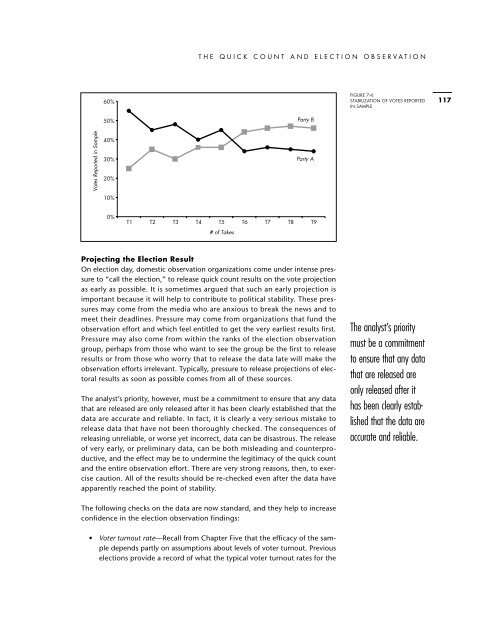The Quick Count and Election Observation
The Quick Count and Election Observation
The Quick Count and Election Observation
You also want an ePaper? Increase the reach of your titles
YUMPU automatically turns print PDFs into web optimized ePapers that Google loves.
THE QUICK COUNT AND ELECTION OBSERVATION<br />
60%<br />
50%<br />
Party B<br />
FIGURE 7-4:<br />
STABILIZATION OF VOTES REPORTED<br />
IN SAMPLE<br />
117<br />
Votes Reported in Sample<br />
40%<br />
30%<br />
20%<br />
10%<br />
Party A<br />
0%<br />
T1<br />
T2 T3 T4 T5<br />
T6 T7 T8 T9<br />
# of Takes<br />
Projecting the <strong>Election</strong> Result<br />
On election day, domestic observation organizations come under intense pressure<br />
to “call the election,” to release quick count results on the vote projection<br />
as early as possible. It is sometimes argued that such an early projection is<br />
important because it will help to contribute to political stability. <strong>The</strong>se pressures<br />
may come from the media who are anxious to break the news <strong>and</strong> to<br />
meet their deadlines. Pressure may come from organizations that fund the<br />
observation effort <strong>and</strong> which feel entitled to get the very earliest results first.<br />
Pressure may also come from within the ranks of the election observation<br />
group, perhaps from those who want to see the group be the first to release<br />
results or from those who worry that to release the data late will make the<br />
observation efforts irrelevant. Typically, pressure to release projections of electoral<br />
results as soon as possible comes from all of these sources.<br />
<strong>The</strong> analyst’s priority, however, must be a commitment to ensure that any data<br />
that are released are only released after it has been clearly established that the<br />
data are accurate <strong>and</strong> reliable. In fact, it is clearly a very serious mistake to<br />
release data that have not been thoroughly checked. <strong>The</strong> consequences of<br />
releasing unreliable, or worse yet incorrect, data can be disastrous. <strong>The</strong> release<br />
of very early, or preliminary data, can be both misleading <strong>and</strong> counterproductive,<br />
<strong>and</strong> the effect may be to undermine the legitimacy of the quick count<br />
<strong>and</strong> the entire observation effort. <strong>The</strong>re are very strong reasons, then, to exercise<br />
caution. All of the results should be re-checked even after the data have<br />
apparently reached the point of stability.<br />
<strong>The</strong> analyst’s priority<br />
must be a commitment<br />
to ensure that any data<br />
that are released are<br />
only released after it<br />
has been clearly established<br />
that the data are<br />
accurate <strong>and</strong> reliable.<br />
<strong>The</strong> following checks on the data are now st<strong>and</strong>ard, <strong>and</strong> they help to increase<br />
confidence in the election observation findings:<br />
• Voter turnout rate—Recall from Chapter Five that the efficacy of the sample<br />
depends partly on assumptions about levels of voter turnout. Previous<br />
elections provide a record of what the typical voter turnout rates for the


